| Oracle® Fusion Middleware Concepts and Architecture for Oracle Service Bus 11g Release 1 (11.1.1.4.0) Part Number E15020-02 |
|
|
View PDF |
| Oracle® Fusion Middleware Concepts and Architecture for Oracle Service Bus 11g Release 1 (11.1.1.4.0) Part Number E15020-02 |
|
|
View PDF |
This section discusses the current focus on service-driven IT strategies, key business drivers for Service-Oriented Architecture (SOA) initiatives and the strategic significance of an Enterprise Service Bus (ESB) component. It provides a conceptual overview of Oracle Service Bus infrastructure solution and functional capabilities that distinguish it as an SOA success factor. It is intended for management stakeholders responsible for SOA initiatives, integration-focused IT architects, service modelers or designers, and system administrators.
The following topics are included in this section:
In today's highly competitive global market, businesses operate in a very liquid environment in which information is the most strategic asset. Responding rapidly to changes in competition, market dynamics, and regulatory mandates, with timely information, is critical for the effective functioning and overall success of businesses. To meet rapidly changing market demands, businesses have become increasingly service-driven, both in the ways they interact with customers and partners, and in how they design and build their IT infrastructure.
As businesses strive to deliver ROI through increased agility and responsiveness, they depend on enterprise IT groups to find new and cost effective means to deliver new services and to promote the free flow of information and business processes within the organization. The following business drivers have made service-oriented IT architectures an economic reality in today's enterprise:
Industry adoption of Web services to rapidly expose and enable new and legacy services
Necessity to build system-centric processes spanning applications and users
Necessity to quickly expose processes as services
Execute mission-critical processes securely and consistently, with transactional integrity
Develop fine-grained integrated application and process control
Deliver high performance execution for straight-through processing
Service-Oriented Architecture (SOA) has emerged as the leading IT agenda for infrastructure reformation, to optimize service delivery and ensure efficient business process management. Part of the paradigm shift of SOA are fundamental changes in the way IT infrastructure is designed—moving away from an application infrastructure to a converged service infrastructure. Service-Oriented Architecture enables discrete functions contained in enterprise applications to be organized as layers of interoperable, standards-based shared "services" that can be combined and reused in composite applications and processes.
In addition, this architectural approach also allows the incorporation of services offered by external service providers into the enterprise IT architecture. As a result, enterprises are able to unlock key business information in disparate silos, in a cost-effective manner. By organizing enterprise IT around services instead of around applications, SOA helps companies achieve faster time-to-service and respond more flexibly to fast-paced changes in business requirements.
In recent years, many enterprises have evolved from exploring pilot projects using ad-hoc adoption of SOA and expanded to a defined repeatable approach for optimized enterprise-wide SOA deployments. All layers of an IT SOA architecture have become service-enabled and comprise of presentation services, business processes, business services, data services, and shared services.
A major challenge for SOA initiatives is attributed to the inherently heterogeneous multi-vendor IT landscape in many enterprises, and the resultant individual silos of business information. Rather than incur the cost and complexity of replacing disparate components of legacy infrastructure, enterprises often choose to extend existing business applications as services for use in other business processes and applications.
The influx of Web service interfaces to functionality within existing packaged applications, often introduces services that do not adhere to established service and compliance guidelines. This is especially true if the services are published from core enterprise systems such as CRMs, Data Warehouses, and ERPs.
In the absence of robust and comprehensive service infrastructure solutions, developers have used a variety of "middleware" technologies to support program-to-program communication, such as object request brokers (ORBs), message-oriented middleware (MOM), remote procedure calls (RPC). More recently, IT infrastructure developers hard-coded complex integration logic as point-to-point connections to web services, in order to integrate disparate applications and processes. This inevitably resulted in complex service sprawls within enterprise IT environments. The following figure illustrates a typical static service integration scenario.
The following are other service related challenges attributed to heterogeneous IT architectures:
Tightly-coupled business services integration due to complex and rigid hard-wired connections
Difficulty managing deployed services due to disparate protocols and applications involved
High total cost of ownership for the enterprise
Impaired ability to reuse services
Inherent replication of transport, transformation, security, and routing details
Exponential redevelopment and redeployment efforts when service end-point interfaces change
Inevitable service disruption that significantly impact service consumers
Enterprise architects and web service modelers with goals to streamline IT infrastructure now require enterprise service capabilities that address the following IT needs:
Simplify access and updates to data residing in different sources
Reuse services developed across the enterprise and effectively manage their life cycle
Provide dynamic configuration of complex integration logic and message routing behavior
Enable run-time configuration capabilities into the service infrastructure
Ensure consistent use of the enterprise services
Ensure enterprise services are secure and comply with IT policies
Monitor and audit service usage and manage system outages
In an SOA initiative, composition is an integral part of achieving business flexibility through the ability to leverage existing assets in higher-order functions.Within a mature SOA environment, complete business applications are composed using existing services to quickly meet the business needs. Flexibility in the service provisioning process, is achieved by avoiding coding logic in service implementations.
Many organizations develop services at very granular levels and the proliferation of many small specific services are difficult to compose into broader logical services. Layering of Services is as a way of breaking out of the limitations of monolithic applications and shortening development, release and test cycles. By defining a layered approach to service definition and construction, the service infrastructure team can achieve the right mix of granular and course-grained services required to meet their current and future business demands.
Service Layers typically comprise of the following services:
Physical Services: that may represent functions that retrieve data in its raw form
Canonical Services: that may define a standard view of information for the organization, leveraging industry-standard formats and supporting a very wide data footprint
Logical Services: that provide a more client-specific granular view of information, generated at compile time using highly-optimized queries
Application Services: that are consumed directly by applications in a line-of-business dependent fashion and may be exposed through presentation services
The core of SOA success depends on an Enterprise Service Bus (ESB) that supports dynamic synergy and alignment of business process interactions, continual evolution of existing services and rapid addition of new ones. To realize the benefits of SOA, it is imperative that IT organizations include a robust and intelligent service intermediary that provides a layer of abstraction to mask the complexities of service integration in heterogeneous IT environments, typical in today's enterprises. While an intermediary layer of abstraction previously implied a platform for customizing enterprise applications, today it implies toolkits for service customization and scalable infrastructures that support loosely coupled service interactions with a focus on service mediation.
ESBs have been instrumental in the evolution of integrated middleware infrastructure technology by combining features from previous technologies with new services, such as message validation, transformation, content-based routing, security and load balancing. ESBs use industry standards for most of the services they provide, thus facilitating cross-platform interoperability and becoming the logical choice for companies looking to implement SOA.
An ESB provides an efficient way to build and deploy enterprise SOA. ESB is a concept that has gained the attention of architects and developers, as it provides an effective approach to solving common SOA hurdles associated with service orchestration, application data synchronization, and business activity monitoring. In its most basic form, an ESB offers the following key features:
Web services: support for SOAP, WSDL and UDDI, as well as emerging standards such as WS-Reliable Messaging and WS-Security
Messaging: asynchronous store-and-forward delivery with multiple qualities of service
Data transformation: XML to XML
Content-based routing: publish and subscribe routing across multiple types of sources and destinations
Platform-neutral: connect to any technology in the enterprise, e.g. Java, .Net, mainframes, and databases
A robust SOA suite offers:
Adapters, to enable connectivity into packaged and custom enterprise applications, as well as leading technologies.
Distributed query engine, for easily enabling the creation of data services out of heterogeneous data sources
Service orchestration engine, for both long-running (stateful) and short-running (stateless) processes
Application development tools, to enable the rapid creation of user-facing applications
Presentation services, to enable the creation of personalized portals that aggregate services from multiple sources
Using ESBs offers greater flexibility for enterprises to connect heterogeneous resources, by eliminating the need for brittle high-maintenance point-to-point connections. Adding an ESB intermediary between service consumers and service providers, shields them from the implementation details of underlying service end-point interfaces, reducing or eliminating the redevelopment and redeployment impacts at the service-consumer level.
Best in class enterprises have achieved SOA success by harnessing high-speed enterprise-ready ESB intermediaries that strategically integrate service mediation capabilities and business process management functionality. Recognizing the significance of operational service management as a critical SOA success factor, they have implemented solutions that provide enterprise-class service scalability, reliability, customization and security. By adopting such solutions built specifically for management and governance of an SOA service life cycle, these enterprises have obtained the following business benefits:
Minimized costs by accelerating SOA deployment initiatives
Ensured customer satisfaction by assurance of continuous service availability
Insulated service consumers to changes in service infrastructure by virtualizing service end points
Maximized ROI by leveraging shared services infrastructure and using consistent modeling methodologies
Reduced integration burden by simplifying service interactions
Improved effectiveness of SOA initiatives through accurate run-time governance of shared services
Justification of SOA spending by inventory and tracking of run-time services
Accurate cost benefit decisions by measuring the benefit or cost avoidance obtained through SOA
Figure 1-5 Enterprise Integration for SOA
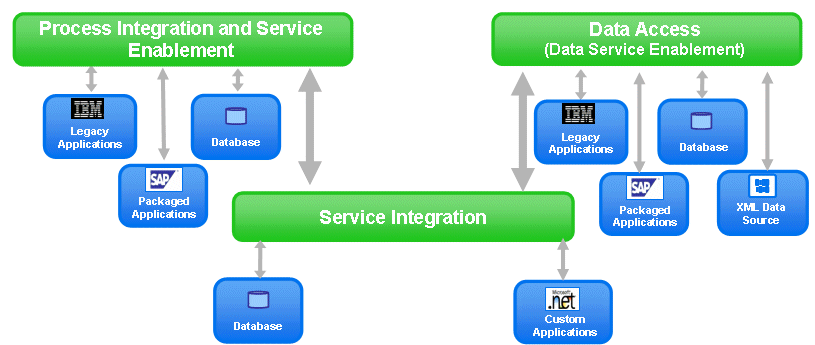
Oracle offers the first service-infrastructure product family built from the ground up for Service-Oriented Architectures, giving IT a unified set of products to successfully deploy an SOA across their organization and achieve better business agility and IT efficiency.
For an overview of Oracle SOA Suite and its component products, see Oracle Fusion Middleware Getting Started with Oracle SOA Suite.
Oracle Service Bus is a proven market-leading Enterprise Service Bus (ESB) built from the ground up for SOA life cycle management that provides foundation capabilities for service discovery and intermediation, rapid service provisioning and deployment, and governance.
This service-infrastructure software adheres to the SOA principles of building coarse-grained, loosely coupled, and standards-based services, creating a "neutral container" in which business functions may connect service consumers and back-end business services, regardless of underlying infrastructure. The following figure illustrates the role of Oracle Service Bus as a service intermediary in an enterprise IT SOA landscape:
Figure 1-6 Oracle Service Bus Intermediary
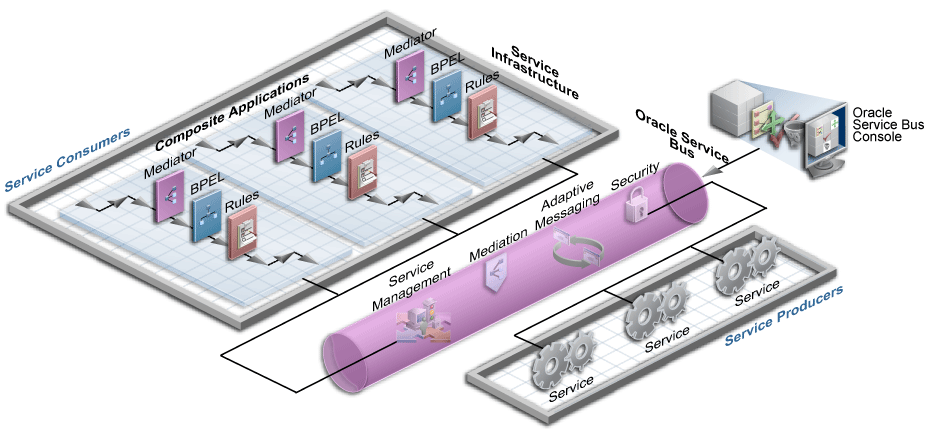
Built to meet exacting standards for reliability, availability, scalability, and performance, Oracle Service Bus uniquely combines the integration capabilities of an Enterprise Service Bus with operational service management, into a single enterprise-class software product, with a layered functional architecture.
Figure 1-7 Oracle Service Bus Functional Features
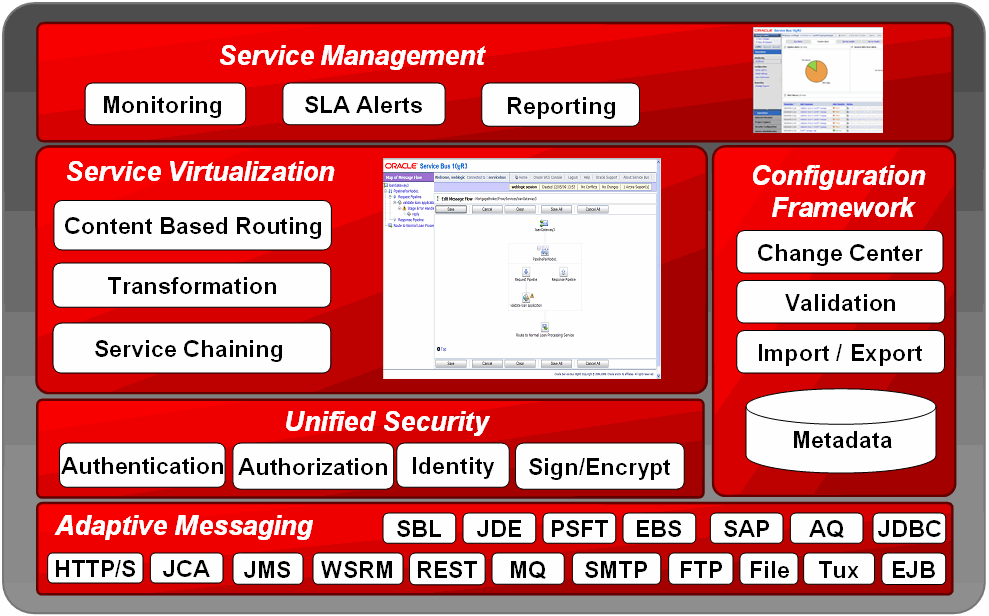
Oracle Service Bus supports an unprecedented level of heterogeneity and can reliably connect any service by leveraging standards. Existing middleware, applications, and data sources become first-class citizens of SOA initiatives, protecting existing IT investments and enabling IT to connect, mediate, and manage services using heterogeneous endpoints, formats, and protocols.
Adaptive messaging provides flexible message handling and manipulation between clients and services. For example, a client could send a SOAP message over HTTP through Oracle Service Bus, which can in turn transform the message and invoke a back-end EJB. Adaptive messaging also supports a variety of communication patterns such as request/response, synchronous and asynchronous, split-join, and publish/subscribe, and even lets you use different patterns for inbound and outbound messages in a single message life cycle.
Figure 1-8 Adaptive Messaging in Oracle Service Bus
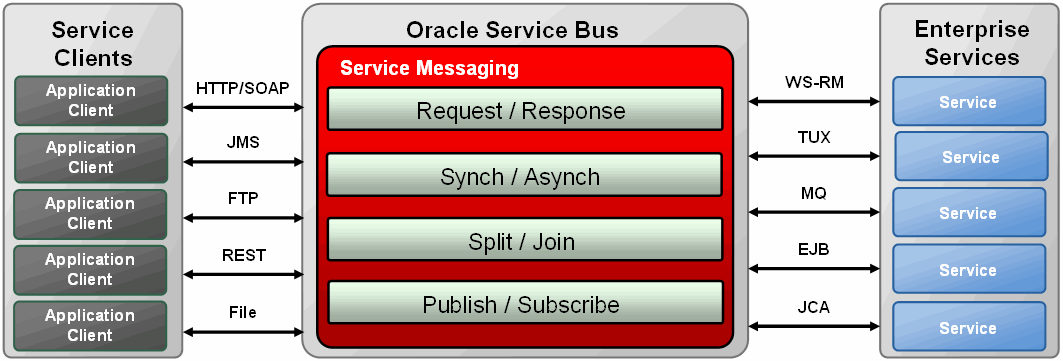
Oracle Service Bus promotes efficient message orchestration by working with traditional messaging protocols and messaging paradigms, including:
Synchronous request/response
Asynchronous publish one-one
Asynchronous publish one-many
Asynchronous request/response (synchronous-to-asynchronous bridging)
In addition to its industry-leading support for Web services, Oracle Service Bus also provides native connectivity to MQ Series, CICS, .NET, C/C++, Java applications. It allows creation and configuration of enterprise-specific custom transports using the Custom Transport Software Development Kit (SDK) and native transport for Oracle Data Service Integrator. It provides the ability to create generic proxy services, using templates, that can accept any SOAP or XML message.
Oracle Service Bus supports optimized database queries across the SOA for high performance and reliability, and interoperability with Web service integration technologies including .NET, Tibco EMS, IBM MQ, IBM WebSphere, Apache Axis, Cyclone B2B Interchange, and iWay adapters.
For information on Oracle Service Bus interoperability, see "Interoperability Scenarios and Considerations" in the Oracle Fusion Middleware Administrator's Guide for Oracle Service Bus and "Oracle Fusion Middleware Supported System Configurations" at http://www.oracle.com/technology/software/products/ias/files/fusion_certification.html.
Based on Oracle Platform Security Services and Oracle WebLogic security framework, Oracle Service Bus ensures service security at all levels. A comprehensive set of components for built-in security gives customers significant flexibility and choice. Users can also plug in custom or third-party security components. Built-in capabilities allow flexibility in implementation by enabling security at all levels. For example:
Transport Security – SSL/Basic Auth and custom security credentials
Message Security - WS-Policy/WS-Security, SAML, UserID/Password, X509, Signing & Encryption, and custom security credentials
Console Security – Web Single-Sign-On and role-based access
Policy Security – WS-Security, Oracle Web Services Manager, and WS-Policy
Oracle Service Bus provides the following security features:
Integration with Oracle Web Services Manager
Authentication, encryption and decryption, and digital signatures as defined in the Web Services Security (WS-Security) specification
Uses SSL to support traditional transport-level security for HTTP and JMS transport protocols
One-way and two-way certificate based authentication
HTTP basic authentication
Encrypt and export of resources (such as service accounts, service key providers, UDDI registries, SMTP providers, and JNDI providers) that contain username and passwords
Create service accounts and service key providers within a session, and add the user name, password, and credential alias binding within the same session.
Configure a service account to pass through user ID and password credentials or map the user to a new user ID and password supplied to a business service
Client-specified custom authentication credentials for both transport- and message-level inbound requests
The Oracle Service Bus security model includes the following:
Inbound Security
Outbound Security
Options for Identity Propagation
Administrative Security
Configuring the WebLogic Security Framework
Supported Standards and Security Providers
Figure 1-9 illustrates security features at different points in a message life cycle.
Figure 1-9 Optimized Pluggable Security Layer
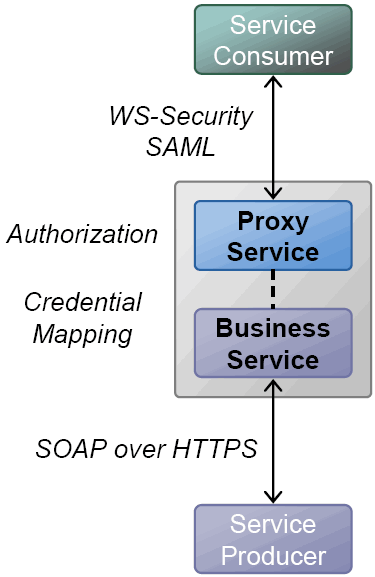
For more information, see Section 3.3, "Oracle Service Bus Security" and the security topics in the Oracle Fusion Middleware Developer's Guide for Oracle Service Bus.
Service Virtualization provides agility through message manipulation and control.
Oracle Service Bus lets you flexibly control messages using validation, transformation, routing based on message content, parallel processing of multiple items in a message, alert triggering, and error handling at different points in a message flow. For example, Oracle Service Bus provides the following capabilities:
XQuery-based policies or callouts to external services for message routing
Routing policies that apply to both point-to-point and one-to-many routing scenarios (publish). For publish, routing policies serve as subscription filters
Routing table abstracted from proxy services, that enables modification of routes without having to re-configure proxy service definitions
Identity-based routing, to classify clients into user-defined groups and apply routing policies based on these groups
All routing logic pertaining to communications with a service end point is handled with configured proxy services. This frees service consumers from having to understand any of the complexities of communicating with back-end services. Decoupling the routing, transformation, security, and transport details from the service consumers and providers and placing them within configurable proxy services, provides for more flexible service integration.
Oracle Service Bus supports dynamic content-based routing of messages and run-time protocol selection. It facilitates these capabilities by allowing the configuration of proxy services with interfaces that are independent of the end-point business services. Using generic proxy templates, proxy services can be configured as message-flow definitions with routing logic that dynamically route messages to appropriate business services, based on message content.
Oracle Service Bus supports the following capabilities for the transformation or processing of messages:
Validates incoming messages against schemas
Selects a target service or services, based on the message content or message headers
Transforms messages based on the target service
Transforms messages based on XQuery or XSLT
Supports transformations on both XML and MFL messages
Message enrichment
Supports callouts to Web services to gather additional data for transformation (for example, country code, full customer records, and so on)
Oracle Service Bus provides a service callout action that offers greater flexibility for more sophisticated message flows for complex dynamic-routing processing, or to perform message enrichment. The service callout action is used inside a message flow routing stage, to call on the destination service to perform some action on the message. The Service Callout functionality supports features such as RPC Encoding and URL replacement and offers extensibility of Oracle Service Bus capabilities by using Java Callouts and POJOs. For more information on service callouts, see "Constructing Service Callout Messages" in the Oracle Fusion Middleware Administrator's Guide for Oracle Service Bus.
Oracle Service Bus provides a database lookup function using a new XQuery function in the Oracle XQuery engine. This can be used for message enrichment, for routing decisions or for customizing the behavior of a proxy service. Read-access to databases from proxy services is supported without requiring writing of a custom EJB or custom Java code and without the need for a separate database product like Oracle Data Service Integrator.
It is implemented using the execute-sql() function to make a JDBC call to a database to perform simple database reads. For more information, see "Accessing Databases using XQuery" in "Modeling Message Flow in Oracle Service Bus" in the Oracle Fusion Middleware Administrator's Guide for Oracle Service Bus.
Two data transformation tools are installed with Oracle Service Bus and Eclipse—the Oracle XQuery Mapper plug-in for Eclipse and Format Builder. Eclipse and Format Builder are supported on Windows platforms only.
You can design business or proxy services in Oracle Service Bus to use the EJB or JEJB transport. Both transports are fully integrated into the Oracle Service Bus configuration, management, monitoring, and test consoles. Business services built with the EJB transport can be used for Publish, Service Callout, and service invocations.
An EJB can be exposed as a Web service, without the need for tools or the modification of the legacy code on the application server that hosts the EJB.
The JEJB transport also lets you invoke services through Oracle Service Bus with plain old Java objects (POJOs)
The Split-Join feature improves service performance by splitting a message payload and processing multiple operations in a message simultaneously rather than one after another, then combining, or joining, all results. For more information, see "Improving Service Performance with Split-Join" in the Oracle Fusion Middleware Administrator's Guide for Oracle Service Bus.
Service Management includes a powerful set of run-time configuration tools for monitoring, alerting, and reporting. In addition to a full set of service management features in the Oracle Service Bus Console, Oracle Service Bus is also fully integrated with Oracle Enterprise Manager for SOA-wide management.
Oracle Service Bus offers embedded service management capabilities that provide optimized governance of all messaging. Its preemptive support ensures that mission-critical business processes continue to serve customer needs, even as business demands, requirements, and workloads change.
Oracle Service Bus allows the following capabilities for auditing and monitoring services:
Gather statistics about message invocations, errors, performance characteristics, messages passed and SLA violations
Send SLA-based alerts as SNMP traps, enabling integration with third-party ESM solutions
Support for logging selected parts of messages for both systems operations and business auditing purposes
Search capabilities by extracting key information from a message and use as it as a search index.
The Oracle Service Bus Console supports tasks performed by users in the operator (IntegrationOperator) role. It provides operational functions and settings that allow users to easily search for resources using Smart Search functionality, monitor SLA alerts, pipeline alerts, logs, reports, turn tracing on and off, and to enable and disable services.
Users can readily distinguish between SLA and pipeline alerts since the metrics reported for each are distinguished on the console and via the JMX monitoring APIs. Service-level flags and global flags help control alerting (SLA & pipeline), reporting, and logging. Operators have privileges to edit operational settings, create new SLA alert rules, and create and edit alert destination resources.
The Oracle Service Bus Console provides a cluster-wide view of service status and statistics. Both business services and Oracle Service Bus proxy services are monitored, as are response times, message counts, and error counts.
The Oracle Service Bus Dashboard provides an unified data service interface for all application development and maintenance, service monitoring and management, and improved operations support. The dashboard allows for monitoring of fault and performance metrics and viewing of aggregated summaries. It allows for dynamically defining and managing routing relationships, transformations, and policies. For more information on Dashboards, see Chapter 6, "Service Management" and Section 6.1.1, "Dashboard."
Figure 1-10 Oracle Service Bus Embedded Service Management
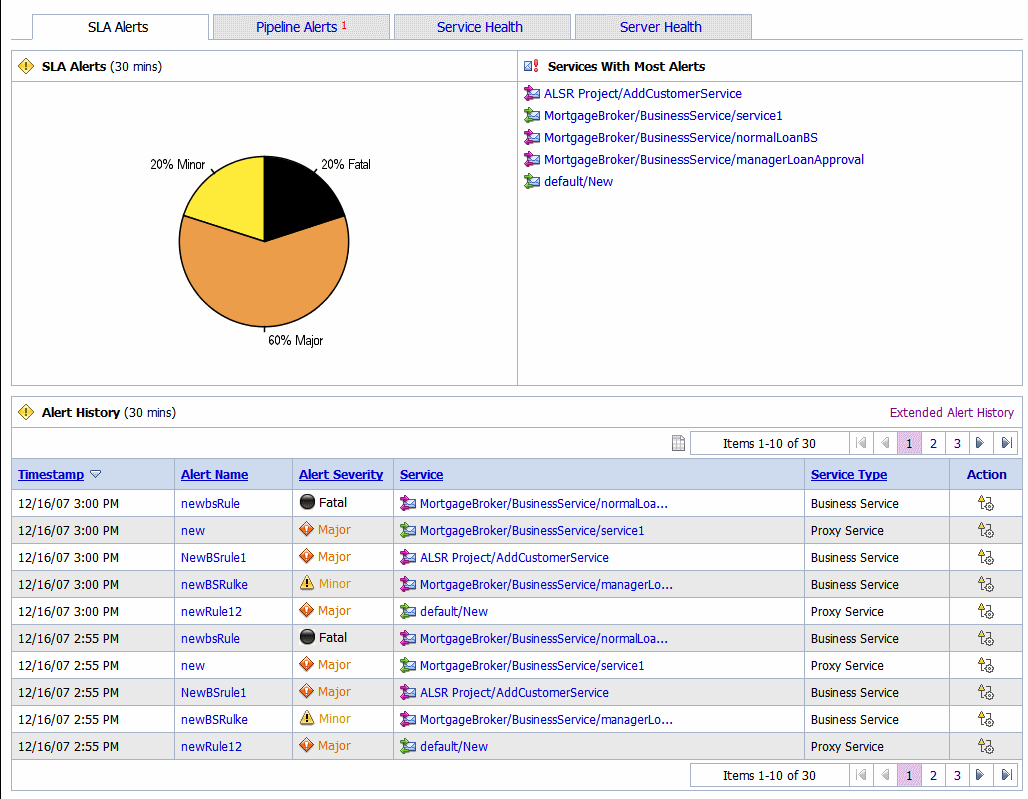
For more information on console operational tasks, see the Oracle Fusion Middleware Administrator's Guide for Oracle Service Bus.
In Oracle Service Bus, monitoring statistics are gathered locally and aggregated centrally. SLA rules are run against aggregated data and the system raises alerts, following which services can be enabled or disabled. Administrators can set service level agreements (SLAs) on the following attributes of proxy services:
Average processing time of a service
Processing volume
Number of errors, security violations, and schema validation errors
Administrators can configure alerts for SLA rule violations
For more information on configuring SLAs, see Chapter 6, "Service Management" and Section 6.1.3, "SLA Enforcement via Alerts."
Oracle Service Bus provides the ability to deploy new versions of services and allows you to have multiple versions of message resources such as WSDLs and schemas. Versions can include changes to the WSDL, the message schema, the headers, and the security parameters.
Oracle Service Bus allows integration of widely adopted third-party reporting tools as well as custom enterprise system management frameworks. In addition, it supports open interfaces for operational and deployment customization, JMX monitoring interfaces, and SNMP Alerts. For more information on reporting features, see Chapter 6, "Service Management" and Section 6.2, "Message Reporting."
The Configuration Framework gives you full control over your Oracle Service Bus production environment..
Oracle Service Bus Console Change Center is key to making configuration changes inside the service bus. The Change Center has the unique ability to lock its current configuration while changes are being made, letting the service bus continue to receive and process requests for services while configuration changes are being made in the console.
Changes being made to the configuration do not affect the current system configuration until they are "activated". The service bus uses the new service and resource configuration when changes are activated. This way, ongoing changes can be made without disrupting services.
Configuration and resource changes you make are tracked, and you can undo or redo changes, resolve conflicts, maintain dependencies among resources, and test changes in the Test Console
For more information on Change Center, see "Using the Change Center" in the Oracle Fusion Middleware Administrator's Guide for Oracle Service Bus.
Oracle Service Bus provides import and export functionality for individual resources and full Oracle Service Bus configurations, and you can maintain resource dependencies and preserve environment variables between environments.
Oracle Service Bus built-in test console is a browser-based test environment used to validate resources and inline XQuery expressions used in the message flow. It is an extension of the Oracle Service Bus Console. Using the test console, it is possible to configure the test object (proxy service, business service, XQuery, XSLT, MFL resource), execute the test, and view test results. It allows message flow tracing when testing a service, to examine the state of the message at specific trace points.
Design-time testing helps isolate design problems before deploying a configuration to a production environment. The test console can test specific parts of a system in isolation and it can test a system as a unit. The test console can be invoked in a number of ways in the Oracle Service Bus Console, from:
The Project Explorer
The Resource Browser
The XQuery Editor
For more information, see "Using the Test Console" in the Oracle Fusion Middleware Administrator's Guide for Oracle Service Bus.
Oracle Service Bus provides the following resource management capabilities:
Stores information about services, schemas, transformations, WSDLs (Web Service Definition Language), and WS Policies.
Provides centralized management and distributed access to resources and services.
Allows browsing of services registered in Oracle Service Bus and import of resources from Eclipse or other applications.
Allows the propagation of configuration data from environment to environment (for example, from a development domain to a test domain to a production domain). The system allows environment specific settings to be overridden during import.
Allows for better synchronization and notification capabilities.
Oracle Service Bus provides a number of APIs for customization of service definitions, WSDLs, schemas, XQueries and other design-time resources through programmatic interfaces. The supporting APIs allow loading ZIP files containing resources, in addition to moving, renaming, cloning, or deleting resources, folders and projects. For more information, see "Oracle Service Bus APIs" in the Oracle Fusion Middleware Administrator's Guide for Oracle Service Bus.
The Configuration Framework also includes a metadata-driven interface for service discovery, publishing, and synchronization using Oracle Enterprise Repository and UDDI registries such as Oracle Service Registry.
Figure 1-11 Service Publishing and Discovery with UDDI

Automatic import and synchronization of services with UDDI registries allows for validation to ensure service integrity and reconciliation of conflicts before deployment. For more information on UDDI registries, see Chapter 4, "Service Configuration" and Section 4.3.1, "UDDI Registry."
Proxy services developed in Oracle Service Bus can be published to a UDDI registry. Oracle Service Bus can interact with any compliant UDDI registry including Oracle Service Registry.
Service definitions in Oracle Service Bus can be synchronized (both ways) with those in UDDI. Services can be auto-published to UDDI after they are created or changed within Oracle Service Bus and business service definitions can be imported from UDDI.
Business services in Oracle Service Bus are also automatically updated (with no human intervention) when the original service is changed in UDDI. Alternatively, the Oracle Service Bus Console can be configured to prompt users for approval for synchronization when a service changes in the UDDI registry. For more information about UDDI registries, see "UDDI" in the Oracle Fusion Middleware Administrator's Guide for Oracle Service Bus and the Oracle Service Registry documentation.
Oracle Service Bus supports the following error handling capabilities:
Configure system to format and send error messages, and return messages for consumers of services who expect a synchronous response
Configure error handling logic for pipeline stages, entire pipeline, and for proxy services
Generate alerts based on message context in a pipeline, to send to an alert destination.
The following table summarizes functional features of the Oracle Service Bus and highlights the business requirements addressed by each functionality.
Table 1-1 Oracle Service Bus Features and Benefits
| Functionality | Functional Feature | Business Benefit |
|---|---|---|
|
Message Routing |
Configuration-driven intelligent, content-based and identity-based routing |
Rapidly respond to business needs by quickly configuring routing rules based on changes to business rules or existing IT systems, without coding |
|
Message Transformation |
Dynamic message transformation based on XQuery or XSLT, supporting multiple message formats |
Flexibly adapt to evolving SOA and integration project scenarios through the ability to dynamically transform and route services using simple and/or complex routing rules and/or message payloads |
|
Service Registry |
Automated or administrator-driven interoperability with UDDI V3 registries for service publishing and reuse |
Increase ease of re-use by automatically discovering existing services and exporting new services to the service registry |
|
Service Provisioning |
Simplified service provisioning |
Increase ease of managing multiple versions of services, simplify and speed deployments by eliminating build-test development cycles |
|
Message Security |
Optimized, pluggable, policy-driven transport and message level security |
Leverage existing investments in security infrastructure and seamlessly broker between multiple security frameworks |
|
Service End-point Interoperability |
Extensibility and expanded service end-point support |
Extend solution to accommodate unique IT requirements using infrastructure with certified interoperability with multiple standards, protocols, and vendors |
|
Service Level Agreements |
Rules-driven, configurable Service Level Agreement (SLA) enforcement |
Gain visibility and control by enabling users to set SLAs based on a number of factors and alerts when the SLAs are not met |
|
Message Transport |
Extensible support for heterogeneous transports between service end points including custom transports via the Custom Transport SDK |
Provides flexibility to leverage existing investments in disparate systems and/or ensure smooth transition from older to newer systems |
|
Adaptive Messaging |
WS-I compliant Intelligent messaging brokering with support for multiple transport types, message formats |
Ensure investment protection and leverage existing infrastructure through the ability to orchestrate services from existing IT systems with disparate messaging protocols without needing to change the systems and styles |
|
Service Availability |
Proactive infrastructure health and availability monitoring with JMX and SNMP |
Maintain health and availability of the SOA through easy configuration of support of performance metrics and SLAs using a built-in, feature-rich dashboard OR 3rd party performance management systems. |
|
Service Monitoring Dashboard |
Flexible, graphical, and embedded management and monitoring dashboard |
Automatically monitor and manage status of performance metrics and SLAs using a built-in, feature-rich dashboard or 3rd party performance management systems. Proactively take corrective action based on alerts. |
|
Service Deployment |
Easy, customizable programmatic or console-driven deployment |
Ability to enforce governance and speed deployments |
Oracle Service Bus is at the heart of Oracle's comprehensive business integration solution and belongs to the Oracle Messaging product line. Oracle Service Bus is primarily targeted for managing different types of services, and providing traditional message brokering across heterogeneous IT environments.
The lightweight, stateless, high-performance architecture of Oracle Service Bus and its converged intelligent message mediation and service life cycle management capabilities, make it an ideal core component of distributed services networks.
It is designed to fit into the broader IT Service-Oriented Architecture (SOA) landscape as a distributed service management intermediary and can be integrated with other Oracle business process management solutions in distributed heterogeneous deployments.
Figure 1-12 Oracle Service Bus Significance in SOA Architecture
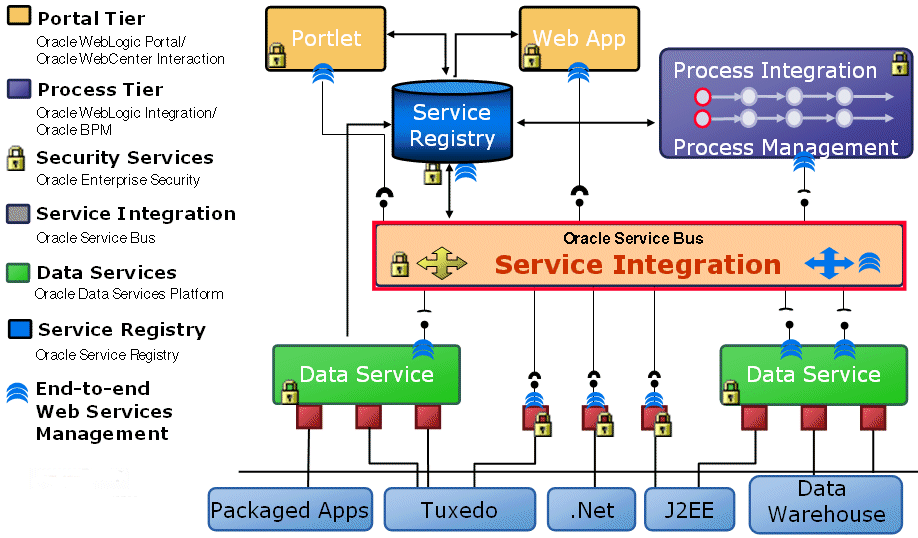
Oracle Service Bus is a powerful lightweight, cost-effective technology that can be used by service developers and architects for the following use cases:
Building an Enterprise-Wide SOA: A backbone that transports and routes messages across an enterprise, for configuring request-and-response message flows between service consumers and service providers.
Building reusable atomic services: Facilitates organizational flexibility and promotes application integration and data synchronization across multiple applications.
Creating composite applications: Rapidly build new applications that access services of existing applications from a shared service catalog, reducing time to market through reuse.
Business Activity Monitoring (BAM): Enables business users to get access to key performance indicators and act on business alerts, listen for business events flowing through the infrastructure, and orchestrate services in response to these events, using portals that provide a personalized view of enterprise services.
The life cycle of a service comprises of the following two phases:
Design phase: The service architecture team identifies an organization's business needs and models a number of services and application interfaces to support those needs
Run-time phase: The services modeled using the catalog of business needs are used as a roadmap for service creation and exposed as run-time offerings within the organization.
Oracle Service Bus plays an integral part in the service life cycle run-time phase. It facilitates the following important functions in the services life cycle:
Promotes logical or conceptual layering of the system by allowing for design and provisioning layered services during the run-time phase. This ensures run-time flexibility and no loss of agility at provisioning time.
Manages and monitors the flow of messages between consumers and providers.
Insulates users and processes from service changes by abstracting services and removing shared integration logic from service endpoints.
Provides service transformation, validation, enrichment and routing - by bridging protocols, message styles, security and data formats.
Provides visibility and operational service management - by exposing services for use by consumers.
A key design philosophy of Oracle Service Bus is the physical separation of management functions from service implementations. As part of an enterprise's messaging fabric, Oracle Service Bus can be used horizontally integrate many applications and systems, spanning service implementations in different departments built by different teams.
As services are created, they are registered and exposed for later consumption by other services or processes. Services can be registered directly with Oracle Service Bus in its local service registry, or imported from an enterprise service registry such as the Oracle Service Registry. After services are registered with Oracle Service Bus, it configures proxy interfaces that define the message flow for communicating with these services.
This flow contains any transformation and security requirements that must be applied, as well as specifications for routing the message to the service. After services are registered with Oracle Service Bus, business processes, such as those created with Oracle WebLogic Integration, can consume these services and orchestrate them to support various business contexts. These orchestrated processes define how the services are used and applied to business requirements and fine-grained business processes. These business processes are then exposed for use by end users through a user interface (UI), which could be a transactional portal such as Oracle WebLogic Portal or a collaborative portal such as Oracle User Interaction.
Oracle Service Bus again steps into the life cycle to monitor and manage message flow, system health, and availability between service end points. This information may be reported to business and operations analysts who can analyze it for patterns of behavior indicating where improvements should be made. The life cycle begins again as services evolve over time and new versions are released.